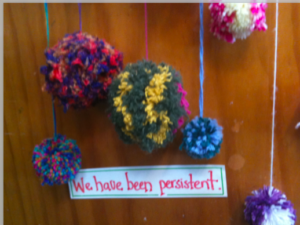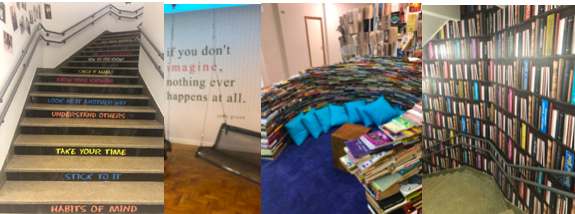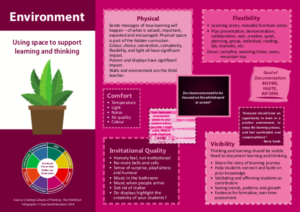Using the Classroom Space to Promote Thinking and Learning
According to a Harvard study of communication, it only takes seven seconds to make a first impression. Your classroom environment communicates many things about your teaching style, and the learning going on in the classroom. Ron Ritchhart asserts your classroom environment sends messages to your students about what you value, how you think learning happens and what kinds of learning and thinking is to be celebrated. He continues to say, “Environments also send messages about how students are to move and interact in a space with others, either connecting us as community or making that connection more of a challenge.”
Of course, great teaching can happen in a garden shed and indeed any space, and the question to consider is does the environment fully support, embrace and bring out the best in your learners?
Is the furniture arranged to support the ‘sage on the stage’ notion or that you value interaction, team work and collaboration? Does your classroom environment show teacher directed or student led learning?
The classroom environment sends messages about the hidden curriculum, what you value, is important and what is expected and encouraged.
In his book, Creating Cultures of Thinking, Ron Ritchhart outlines 5 factors to consider when setting up a classroom which promotes thinking and learning.
1. Physical Environment: This sends messages of how learning will happen and of what is valued, important, expected and encouraged. Your physical space is part of the hidden curriculum – the what really goes on here. Reggio Emilia talks about the walls in your classroom being the third teacher. However, just having the posters of information on the walls is not enough. I once had a Principal tell me that a programme he had introduced into his school had not worked. He went on to say that they had displayed the information in every classroom for 2 years and it didn’t work! Posters alone do not teach, they often become invisible wallpaper. Displays show what we value, and it is then the teachers task to explicitly refer to and teach the ideas and concepts. Jenny Mosley suggests we have to get the information off the walls and into our students’ minds and hearts.
2. Visibility. If learning and thinking are at the core of your classroom it is imperative you show this in your environment. Walk into your classroom with fresh eyes to see what students or a visitor will see. Is the work on the walls perfect, showing that is what is expected? Is there evidence of learning or just the final result? Do your captions capture the process and learning or the completed task?
 The photograph of the pompoms is a great example of who your students are becoming because of the teaching and learning happening in your classroom. The caption might have said “We made Pompoms.” This would show that the end task of the pompom was the goal. The caption “We have been persistent” clearly showcases what the teaching and learning was about as well as the disposition students are encouraged to develop.
The photograph of the pompoms is a great example of who your students are becoming because of the teaching and learning happening in your classroom. The caption might have said “We made Pompoms.” This would show that the end task of the pompom was the goal. The caption “We have been persistent” clearly showcases what the teaching and learning was about as well as the disposition students are encouraged to develop.
Display your students work to show them what the learning process looks like so they can see growth over time, rather than a snap shot moment. Consider whether you display all students work or their best effort. When students know it is not their best effort and it is displayed for all to see (and possibly compare) what happens to their pride and self-esteem? Plus, if all the pictures on the wall look the same, what is the point of displaying them? Displays need to have a learning purpose; to invite reflection, inspire, inform or to show growth.
3. Flexibility. With many different modes and ways of learning in a modern classroom, the space needs to reflect this dynamic approach. A static physical space may be detrimental for learning according to researchers in the UK. Easily moveable furniture is an important factor in making the classroom space more dynamic. For example, rectangle and triangle tables are far easier to move into bigger groups that round tables. Provide flexible seating to reflect the time spent learning, for example, foam cubes and inflatable balls for short group work and chairs for a longer instructional time. Explore the concept of stand up desks for productivity.
Provide clear zones for different activities such as play, presentation, demonstration, collaboration, wet, creative, quiet, planning, group, individual, reading, lab, dramatic etc. David Thornburg identified archetypes which are needed for learning to thrive. These are zones of the campfire (for groups, discussions and processes), watering hole (for encounters and support), cave (for concentration and quiet time), sandpit (for practical making, designing and experimenting) and the mountain top (for presentations, reflection of progress and discovery).
4. Comfort. The opportunity to move and change your posture in a learning environment adds to the comfort of the learner. However, comfort goes beyond the furniture. Take time to reflect on how the lighting, temperature, colour and noise either enhances or distracts from learning.
* Lighting: Many schools have florescent lights as they are the cheapest to use. Fluorescents tubes flicker at a different rate to brain processing causing stress and discomfort. Studies clearly show extended time under florescent lights can cause stress, headaches, dehydration and fatigue. Test this out – turn the lights off in your classroom and ask the students how they feel. In my experience the majority of students comment how much calmer they feel. The best lighting for learning is natural light or lighting that mimics daylight such as full spectrum lighting. Ideally switchable banks of lights and dimmable lights are great.
* Temperature: This is often less able to be controlled, yet the room temperature and air quality does impact learning. If the room is too hot, students become sluggish. Conversely, if the room is too cold the body needs to use extra energy and effort to warm itself up which means less energy for concentration, thinking and learning. Rita and Kenneth Dunns’ research shows the ideal temperature range is between 18-22 degrees Celsius.
 . * Colour is a topic that is still up for debate and when surveyed students prefer more than less. It is agreed that certain colours give off particular vibes. For example, green is used as a calming colour in waiting rooms and prisons. Warm bright colours such as red, orange and deep yellow engender energy and a fast pace (think fast food restaurants) whilst blues, greens, brown and pastels colours (think nature) are more calming.
. * Colour is a topic that is still up for debate and when surveyed students prefer more than less. It is agreed that certain colours give off particular vibes. For example, green is used as a calming colour in waiting rooms and prisons. Warm bright colours such as red, orange and deep yellow engender energy and a fast pace (think fast food restaurants) whilst blues, greens, brown and pastels colours (think nature) are more calming.
* Noise levels are a huge topic in schools with open spaces and teaching needs to be adapted to minimise the noise. Glass walls provide visibility and acoustic privacy. Headphones can screen out noise. Conversations about noise levels and expectations help as well. In many classrooms I have visited recently, I have seen how teachers are explicitly teaching and modelling noise levels with the battery operated push lights.
5. Invitational Qualities. Teachers and students can spend between six to ten hours within the walls of a classroom and school. Just as we want our homes to be practical and inviting, so can our classrooms be. Create an environment that is welcoming for students, parents, colleagues and visitors. Welcoming classrooms often have a sense of playfulness, surprise and fun. At Escola Concept in Sao Paulo, Brazil, the sense of wonder, fun and surprise is abundant in their environment. From the book nook, quotes on the wall, the staircase, the wallpaper up the stairs to the swing seats in the library, it makes the school feel very inviting and emits a feeling of powerful learning.

The learning environment is a key consideration for learning success and whether your school has budgets for change or not, there are many small changes you can make to promote thinking and learning.
Action points include:
• Get down on your knees and view your classroom from a students’ perspective
• Identify what your central classroom focus is. Is it the screen or board? What would you prefer to be at the centre of the learning and teaching in your classroom?
• Consider what you want your classroom environment to say about the teaching and learning going on
• Identify what is not working and modify
• Create some element of surprise, wonder or fun to provoke a smile or encourage learning.
To download a complimentary copy of this infographic please click here
** This article is the sixth in a series of 8, focusing on the 8 Cultural Forces and Cultures of Thinking.
Want to know more?
Please go to www.spectrumeducation.com/cultures-of-thinking-webinar-series for a live webinar or contact us for information about the recorded videos from this series.
To purchase and download all 8 high resolution posters please go to www.spectrumeducation.com/cultures-of-thinking-infographics/
Tags: 8 Cultural Forces, Cultures of Thinking, environment, Karen Tui Boyes
Published on Friday, March 29th, 2019, under Cultures of Thinking, Learning


Extremely useful tips. Thank you